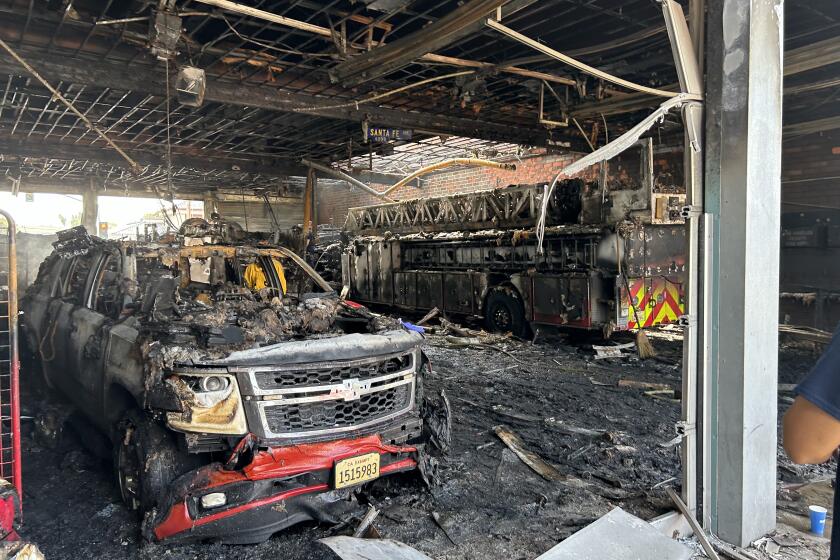Old-Growth Forest Sparks Dispute After Wildfire
EMIGRANT GAP, Calif. -- Part of the Tahoe National Forest that burned in a 2,400-acre wildfire last summer looks just the way one might imagine.
Charred limbs and twigs rise from the scorched, black earth among pockets of standing skeletons of trees with brown needles.
Downed, dead logs of charcoal are scattered across the top of the Sierra a mile south of Interstate 80.
The scene matches the description of the devastation in a Forest Service analysis done for a pending salvage logging project.
“The Gap fire was an unusually complete burn,” the Forest Service’s environmental assessment says. “Very little of the aboveground vegetation in this area appears to have survived.”
But walk a few hundred yards down the Old Stage Road in the 900-acre logging area along the North Fork of the American River, past the woodpeckers and a bear’s 8-inch-long footprints, and you’ll find something you wouldn’t expect:
Big, green trees. Lots of them.
“The Forest Service is claiming the forest is completely dead,” said Chad Hanson, head of the John Muir Project that is fighting the logging with the Earth Island Institute.
“But clearly that’s not the case for at least half of the project area. In most areas the big trees have only been mildly scorched and most of those are going to live,” he said.
He points to dozens of large green stands of incense cedars, red firs, white firs, sugar pines and ponderosa pines, some hundreds of years old and more than 100 feet tall.
“The fire did come through here but it did not destroy the forest. This forest is very clearly alive.”
*
Forest Service scientists say many trees that look alive are actually dead, soon will turn brown and eventually fall to the forest floor to serve as fuel for another, hotter fire.
“I don’t believe Chad has the background he needs in natural resources to tell the difference,” said Bob Cary, Forest Service team leader for the Gap fire salvage project. “I’m not sure he knows exactly what he is looking at.”
The dispute is the latest between Forest Service officials and environmental groups challenging government plans to log forests in the name of reducing fire risks.
The agency and its backers say thinning and salvage operations are essential to reduce dead and dying timber in national forests throughout the West.
“There just aren’t too many places in the timbered areas of California that won’t burn any more,” said Tim Feller of Sierra Pacific Industries, one of the largest landowners in the state. “With the combination of 100 years of fire suppression and forest fuel buildup, it’s a no-brainer any more.”
The Gap fire burned for nearly two weeks last August, closing the interstate between Sacramento and Reno, Nev. The Forest Service estimates the fire killed more than 350,000 trees larger than 2 inches thick, about 90% of the forest.
Steve Eubanks, Forest Service supervisor of the Tahoe National Forest, said some dead wood is good for soil nutrients and wildlife habitat, but “the massive amount represented by all the dead trees presents a problem because, as grasses and brush sprout and grow amid the dead logs, severe fire hazard develops.”
Cary calculates there are enough standing dead trees for one to fall every seven hours for the next 35 years.
*
Salvage logging has been hotly debated since President Clinton drew the ire of environmentalists by signing a pro-logging measure pushed by Northwest Congress members in 1994--a move Vice President Al Gore later called the biggest mistake of Clinton’s first term.
Last month, President Bush said in a statement to a Wildland Fire Conference in Idaho that he wants to promote “sound forest management to restore forest health....
“In many areas, this will require active forest management efforts to thin our forests of excessive natural fuels and restore native vegetation to our forests and rangelands.”
Still, many industry leaders criticize the Forest Service for not moving quickly enough.
In an article headlined “Federal Fiddling While California Burns,” California Forest Products Commission Chairman Donn Zea complained that federal forests grow billions of unharvested board feet each year, creating concentrated fuel for wildfires. Average acres burned in the Sierra jumped from about 300,000 in the mid-1980s to more than 750,000 by the end of the 1990s, Zea said.
“This isn’t happening because people are throwing more matches out their car windows,” he said.
*
Much of the dispute hinges on guidelines used to predict whether a tree is dead or will die.
The Forest Service makes a decision primarily by estimating “crown scorch”--the percentage of the tree’s foliage that has been burned. Agency workers also sometimes hack into the bark to see if the tree’s inner skin, the cambium, has been damaged.
Generally, the Forest Service considers a ponderosa pine to be dead if it has at least 55% crown scorch.
Hanson, who has been active in forest protection for 12 years, and Fazio subscribe to new research that suggests many ponderosa pines survive with as much as 95% crown scorch.
Cary said that defies common sense.
“If you have a tree that is in your front yard and you cut 95% of the foliage off it, is it going to live? It might, but probably not,” he said.
“What we are finding over and over again, particularly with ponderosa pine, is the buds will burst with new foliage the following spring, and some of those will live and continue to grow. But many of them I’ve seen, the new foliage bursts out and it wilts and dies,” Cary said.
Nevertheless, the Forest Service said only dead trees in the Gap fire will be removed--meaning those with no visible green foliage.
The original environmental assessment issued in April estimated 95% of the Gap project area was dead. A flyover May 12 revised the estimate to about 87%, Cary said.
Hanson estimates about half of the forest is dead or dying but the rest will recover. He doesn’t trust the agency to take only dead trees, especially because the area has been closed to the public and no one may observe the logging operation expected to begin this fall.
*
Back on the site, the Old Stage Road wanders through a classic cathedral grove of old-growth trees, with ponderosa pines towering 100 feet in the air. One estimated to be more than 300 years old is more than 4 feet in diameter.
Hanson estimates its crown scorch at 5%. Black scorch marks reach about 5 feet up the bark.
At the other end of the project area, bordering clear-cut private lands, is a large collection of old-growth, which overlaps into an area he says is suitable habitat for the California spotted owl.
Stepping from the hot midday sun on the dusty road into the damp shade of the forest, the temperature drops noticeably.
“You can feel the difference immediately,” Hanson said as mosquitoes began to swarm.
“Even a blind person can tell,” Fazio said. “It doesn’t take a ... forester to tell you you’re in an old-growth forest.”
More to Read
Start your day right
Sign up for Essential California for news, features and recommendations from the L.A. Times and beyond in your inbox six days a week.
You may occasionally receive promotional content from the Los Angeles Times.






